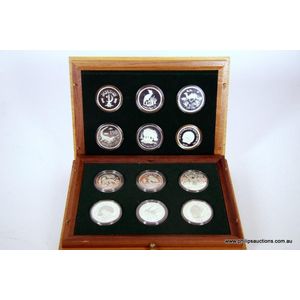US Navy Hamilton Deck Watch, 1942
You must be a subscriber, and be logged in to view price and dealer details.
Subscribe Now to view actual auction price for this item
When you subscribe, you have the option of setting the currency in which to display prices to $Au, $US, $NZ or Stg.
- Date Aperture - A date aperture is a cut out section in the face of a watch or clock, displaying the day of the month.
- Movement - The technical name for the workings of a clock or watch, and does not include the dial or case.
- Baize - Baize is a type of fabric that is made from wool or a wool blend. It is a dense, closely-woven fabric that is smooth to the touch and has a matte finish. Baize is often used for covering surfaces, such as table tops or the playing surface of card, pool and billiard tables, and for lining drawers and boxes, because it is durable and resistant to wear. This fabric is often associated with gambling and is often used on casino gaming tables and other gaming equipment.
- Mahogany - Mahogany is a dense, close grained red-coloured timber from the West Indies and Central America. It was first imported into Europe in the the early 18th century and its use continued through the 19th century. It was popular for furniture making because of its strength, the wide boards available, the distinctive grain on some boards, termed flame mahogany and the rich warm colour of the timber when it was polished.. The "flame" was produced where a limb grew out from the trunk of the tree, and this timber was usually sliced into veneers for feature panels on doors, backs and cornices.
Some terms used to describe mahogany relate to the country from which it originally came, such as "Cuban" mahogany, "Honduras" mahogany etc. However unless the wood has been tested the names assigned are more a selling feature, rather than a true indication of the timber's origin.
This item has been included into following indexes:
Visually similar items

The 2000 Australian proof kookaburra silver coin series Kilo collection, four silver coins of one kilo, ten ounce, two ounce and one ounce from the Perth mint, with certificate of authenticity ed. 195/300, silver purity 999, in box with card sleeve

Three Chinese wooden carved and framed porcelain panels depicting various landscapes with figures, calligraphy to each central panel, each 124 x 38 cm

Set of six sterling silver Australian state medals., 75th Anniversary of Federation reverse coat of arms Obverse map of the state & floral emblem, mounted in timber frame

Twenty four sterling silver coins, the Conservation Coin Collection, circa 1974-76, twenty four coins displayed in four trays, struck by the Royal Mint and issued on behalf of various countries including Thailand, Tanzania, Indonesia, Costa Rica, Nepal, Pa
